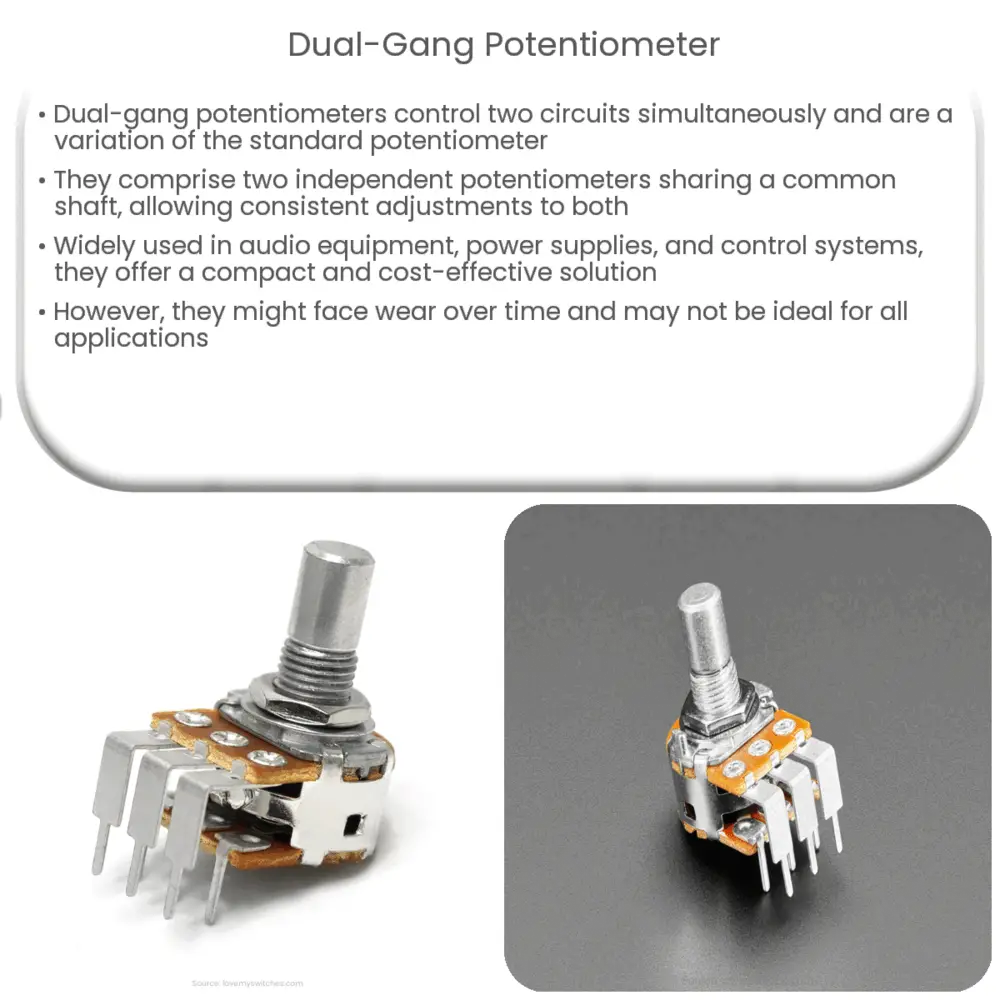A dual-gang potentiometer is a compact electronic component that enables simultaneous control of two separate circuits, commonly used in audio equipment, power supplies, and control systems.

Dual-Gang Potentiometer: An In-Depth Look
Introduction
A dual-gang potentiometer is a versatile electronic component that plays an essential role in controlling two separate circuits simultaneously. It is a variation of the standard potentiometer, which is a three-terminal resistor with a sliding or rotating contact that forms an adjustable voltage divider. This article will explore the design, functionality, and applications of dual-gang potentiometers, highlighting their benefits and limitations in various electronic circuits.
Design and Functionality
Dual-gang potentiometers comprise two independent potentiometers that share a common shaft. This configuration allows the user to adjust both potentiometers simultaneously, ensuring a consistent relationship between the two output voltages. Each potentiometer in the dual-gang configuration operates independently, with separate input and output terminals.
Both rotary and slide-type potentiometers can be designed in a dual-gang configuration. Rotary dual-gang potentiometers typically use a concentric arrangement, where the two potentiometers are stacked on top of each other with their shafts aligned. In contrast, slide-type dual-gang potentiometers feature two side-by-side linear tracks that are adjusted by a single slider. The choice between these two types depends on the specific application and desired form factor.
Applications
Dual-gang potentiometers are widely used in various electronic applications where simultaneous control of two separate circuits is required. Some common applications include:
- Audio equipment: Dual-gang potentiometers are frequently found in audio equipment, such as mixers, amplifiers, and equalizers. They enable the simultaneous control of two audio channels, ensuring consistent volume or tone adjustments across both channels. This feature is particularly useful for stereo sound systems, where maintaining the balance between left and right channels is crucial for optimal audio performance.
- Power supplies: In adjustable power supplies, dual-gang potentiometers can be used to control output voltage and current simultaneously. This allows for precise regulation of power delivered to a load, ensuring stable operation and preventing damage to the connected devices.
- Control systems: Dual-gang potentiometers are employed in control systems that require simultaneous adjustments to multiple parameters. For example, they can be used in industrial automation systems to control the speed and direction of motors or in lighting control systems to manage color temperature and intensity.
Despite their versatility, dual-gang potentiometers have some limitations. They may not be suitable for applications requiring independent control of the two potentiometers or fine adjustments of individual potentiometer settings. Additionally, the mechanical coupling of the two potentiometers can introduce potential wear and reliability issues over time.
Benefits of Dual-Gang Potentiometers
Using dual-gang potentiometers in electronic circuits offers several advantages, such as:
- Compact design: Dual-gang potentiometers integrate two potentiometers into a single component, reducing the overall size and complexity of a circuit. This streamlined design is especially beneficial in applications with limited space or where component count needs to be minimized.
- Consistent control: The shared shaft ensures that the two potentiometers are adjusted simultaneously, maintaining a consistent relationship between the output voltages. This is crucial in applications where precise control of multiple parameters is required.
- Cost-effective solution: By combining two potentiometers into a single component, dual-gang potentiometers can be more cost-effective than using separate, individual potentiometers for each circuit.
Limitations of Dual-Gang Potentiometers
Despite their numerous benefits, there are some limitations associated with dual-gang potentiometers, which include:
- Mechanical wear: The mechanical coupling of the two potentiometers can lead to wear and tear over time, potentially affecting the performance and reliability of the component. Regular maintenance and replacement may be required to ensure long-term functionality.
- Less precise adjustments: Due to the shared shaft, it can be challenging to make fine adjustments to individual potentiometers independently, which may be necessary in some applications.
- Compatibility: Dual-gang potentiometers may not be suitable for applications requiring independent control of the two potentiometers or where different potentiometer values are needed for each circuit.
Conclusion
Dual-gang potentiometers are versatile and practical electronic components that enable simultaneous control of two separate circuits. They are widely used in audio equipment, power supplies, and control systems, providing a compact, cost-effective solution for various applications. However, they also have some limitations, such as potential wear and reliability issues, and may not be suitable for all applications. When selecting a dual-gang potentiometer, it is essential to carefully consider the specific requirements and constraints of the intended application to ensure optimal performance and reliability.

